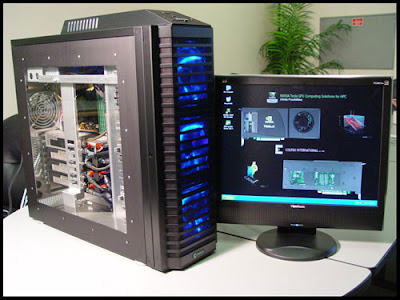Supercomputer:
A
supercomputer is a computer that performs at or near the currently highest operational
rate for computers. A supercomputer is typically used for scientific and engineering
applications that must handle very large databases or do a great amount of computation
(or both). At any given time, there are usually a few well-publicized supercomputers
that operate at the very latest and always incredible speeds. Perhaps the
best-known builder of supercomputers has been Cray Research, now a part of
Silicon Graphics. Some supercomputers are at "supercomputer center,"
usually university research centers, some of which, in the United States, are
interconnected on an Internet backbone (A backbone is a larger transmission
line that carries data gathered from smaller lines that interconnect with it)
known as vBNS or NSFNet.
At
the high end of supercomputing are computers like IBM's "Blue
Pacific," announced on October 29, 1998. Built in partnership with
Lawrence Livermore National Laboratory operations per second), 15,000 times
faster than the average personal computer. It consists of 5,800 processors
containing a total of 2.6 trillion bytes of memory and interconnected with five
miles of cable.
Mainframe:
A
very large and expensive computer capable of supporting hundreds, or even thousands,
of users simultaneously. In the hierarchy that starts with a simple microprocessor
(in watches, for example) at the bottom and moves to supercomputers at the top,
mainframes are just below supercomputers. In some ways, mainframes are more powerful
than supercomputers because they support more
simultaneous programs. But supercomputers can execute a single program faster
than a mainframe. The distinction between small mainframes and minicomputers is
vague, depending really on how the manufacturer wants to market its machines.
Server/ Minicomputer
A
midsized computer. In size and power, minicomputers lie between workstations
and mainframes. In the past decade, the distinction between large
minicomputers and small mainframes has blurred, however, as has the distinction
between small minicomputers and workstations. But in general, a minicomputer is
a multiprocessing system capable of supporting from 4 to about 200 users simultaneously.
Desktop
These
are also called microcomputers. Low-end desktops are called PC’s and high-end
ones “Workstations”. These are generally consisting of a single processor only,
sometimes 2, along with MB’s of memory, and GB’s of storage. PC’s are used for
running productivity applications, Web surfing, messaging. Workstations are
used for more demanding tasks like low-end 3-D simulations and other
engineering & scientific apps. These are not as reliable and fault-tolerant
as servers. Workstations cost a few thousand dollars; PC around a $1000.
Portable Computers:
Portable
computer is a personal computer that is designed to be easily transported and relocated,
but is larger and less convenient to transport than a notebook computer. The earliest
PCs designed for easy transport were called portables. As the size and weight
of most portables decreased, they became known as laptop computer and later as
notebook computer. Today, larger transportable computers continue to be called portable
computers. Most of these are special-purpose computers – for example, those
for use in industrial environments where they need to be moved about
frequently.







No comments:
Post a Comment